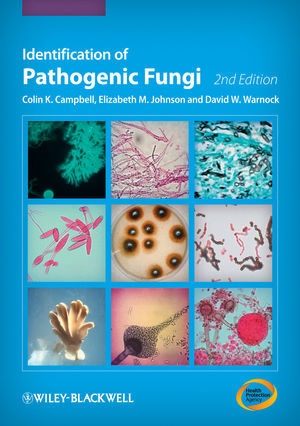Read more
Informationen zum Autor Colin K. Campbell , Health Protection Agency Mycology Reference Laboratory, Bristol, UK (retired) Elizabeth M. Johnson , Health Protection Agency Mycology Reference Laboratory, Bristol, UK David W. Warnock , National Center for Emerging and Zoonotic Infectious Diseases, Centers for Disease Control and Prevention, Atlanta, GA, USA Klappentext Since the first edition of Identification of Pathogenic Fungi, there has been incredible progress in the diagnosis, treatment and prevention of fungal diseases: new methods of diagnosis have been introduced, and new antifungal agents have been licensed for use. However, these developments have been offset by the emergence of resistance to several classes of drugs, and an increase in infections caused by fungi with innate resistance to one or more classes.Identification of Pathogenic Fungi, Second Edition, assists in the identification of over 100 of the most significant organisms of medical importance. Each chapter is arranged so that the descriptions for similar organisms may be found on adjacent pages. Differential diagnosis details are given for each organism on the basis of both colonial appearance and microscopic characteristics for the organisms described.In this fully updated second edition, a new chapter on the identification of fungi in histopathological sections and smears has been added, while colour illustrations of cultures and microscopic structures have been included, and high quality, four colour digital images are incorporated throughout. Zusammenfassung There is widespread agreement that opportunistic fungal infections, such as aspergillosis and candidosis, are no longer uncommon disorders. These infections are occurring in ever-increasing numbers among neutropenic cancer patients, transplant recipients, and patients with AIDS. Inhaltsverzeichnis Preface, ix Acknowledgements, xi 1 Introduction, 1 2 Identification of Moulds, 11 Media for Mould Identification, 14 Mounting Fluids, 16 3 Moulds with Arthrospores, 18 Neoscytalidium dimidiatum, 20 Coccidioides species, 24 Onychocola canadensis, 28 4 Moulds with Aleuriospores: I. The Dermatophytes, 31 Microsporum gypseum, 38 Microsporum canis, 40 Microsporum equinum, 42 Epidermophyton floccosum, 44 Trichophyton terrestre, 46 Trichophyton rubrum, 48 Trichophyton interdigitale, 52 Trichophyton mentagrophytes, 54 Trichophyton erinacei, 56 Trichophyton equinum, 58 Trichophyton soudanense, 60 Microsporum persicolor, 62 Trichophyton tonsurans, 64 Microsporum audouinii, 66 Trichophyton violaceum, 68 Trichophyton verrucosum, 70 Trichophyton schoenleinii, 72 Trichophyton concentricum, 74 Other Microsporum and Trichophyton species, 76 5 Moulds with Aleuriospores: II. Others, 80 Geomyces pannorum, 82 Chrysosporium keratinophilum, 84 Myceliophthora thermophila, 86 Histoplasma capsulatum, 88 Blastomyces dermatitidis, 92 Paracoccidiodes brasiliensis, 96 6 Moulds with Holoblastic Conidia, 99 Aureobasidium pullulans, 102 Sporothrix schenckii, 104 Cladophialophora bantiana, 106 Cladosporium sphaerospermum, 108 Fonsecaea pedrosoi, 110 Rhinocladiella atrovirens, 112 Rhinocladiella mackenziei, 114 Ochroconis gallopava, 116 Alternaria alternata, 118 Ulocladium chartarum, 120 Curvularia lunata, 122 Bipolaris hawaiiensis, 124 Exserohilum rostratum, 126 7 Moulds with Enteroblastic Conidia Adhering in Chains, 129 Aspergillus flavus species complex, 134 Aspergillus fumigatus species complex, 136 Aspergillus glaucus, 138 A...
List of contents
1. Introduction; life histories of the major groups of fungi and their spore types
2. Identification of moulds; laboratory aspects of growing and examining moulds
3. Moulds with aleuriospores I. The dermatophytes
- Microsporum canis
- Microsporum equinum
- Microsporum gypseum
- Microsporum fulvum
- Epidermophyton floccosum
- Trichophyston terrestre
- Microsporum persicolor
- Trichophyton equinum
- Trichophyton erinacei
- Trichophyton mentagrophytes
- Trichophyton interdigitale
- Trichophyton rubrum
- Trichophyton rubrum (granular form)
- Trichophyton tonsurans
- Trichophyton soudanense
- Microsporum audouinnii
- Trichophyton schoenleinii
- Trichophyton verrucosum
- Trichophyton violaceum
- Trichophyton concentricum
- Other Microsporum and Trichophyton species
4. Moulds with aleuriospores II. Others
- Geomyces pannorm
- Chrysosporium keratinophilum
- Myceliophthora thermophia
- Histoplasma capsulatum
- Blastomyces dermatitidis
- Paracoccidioides brasiliensis
5. Moulds with holoblastic conidia
- Aureobasidium pullulans
- Sporothrix schenckii
- Cladophialophora carrionii
- Cladophialophora bantiana
- Cladosporium sphaerospermum
- Cladosporium herbarum
- Cladosporium cladosporioides
- Fonsecaea pedrosoi
- Rhinocladiella atrovirens
- Ramichloridium mackenziei
- Ochroconis gallopava
- Alternaria alternata
- Ulocladium chartarum
- Curvularia lunata
- Bipolaris hawaiiensis
- Bipolaris australiensis
- Exserohilum rostratum
- Exserohilum longirostratum
- Exserohilum mcginnisii
6. Moulds with enteroblastic conidia adhering in chains
- Asergillus flavus
- Aspergillus fumigatus
- Aspergillus glaucus
- Aspergillus nidulans
- Aspergillus versicolour
- Aspergillus ustus
- Aspergillus niger
- Aspergillus terreus
- Aspergillus cadidus
- Penicillium marneffei
- Scopulariopsis brevicaulis
- Paecilomyces lilacinus
- Paecilomyces variotii
7. Moulds with enteroblastic conidia adhering in wet masses
- Cylindrocarpon lichenicola
- Fusarium dimerum
- Fusarium semitectum
- Fusarium moniliforme
- Fusarium oxysporum
- Fusarium solani
- Acremonium strictum
- Acremonium kiliense
- Lecythophora mutabilis
- Lecythophora hoffmannii
- Phialemonium spp.
- Scedosporium prolificans
- Scedosporium apiospermum
- Phialophora parasitica
- Phialophora richardsiae
- Phialophora verrucosa
- Phaeoannellomyces werneckii
- Exophiala spinifera
- Exophiala dermatitidis
- Exophiala jeanselmei
8. Mucoraceous moulds and their relatives
- Cunninghamella bertholletiae
- Absidia corymbifera
- Rhizomucor pusillus
- Mucor circinelloides
- Rhizopus microsporus
- Rhizopus arrhizus
- Rhizopus stolonifer
- Mucor hiemalis
- Mucor racemosus
- Basidiobolus ranarum
- Conidiobolus coronatus
- Pythium insidiosum
- Apophysomyces
Report
"Clinicians, microbiology laboratory personnel, and students will all find this reference source valuable." ( Clinical Infectious Diseases , 22 August 2014)

